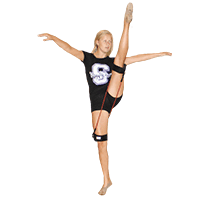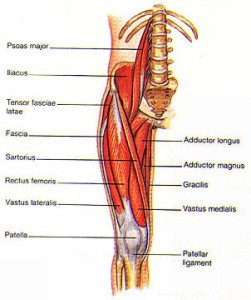In dance, leg extensions are classified as the lifting of one leg to the front, back or the side of the body. Leg extensions occur in ballet, modern dance, jazz and other types of dance. These movements can be energetic and vigorous, as in a grand battement or high leg kick, or slow and controlled, as in a développé.
In this article, we will be focusing on the former example of a leg extension, the grand battement. In French, a grand battement means “large beating” or “big kick”. In dance, it is when one leg stays on the ground as the supporting leg while the other leg brushes through tendu and degage and sent up to a 90-degree angle or higher. The leg returns to the floor by brushing back through degage and tendu. In less technical terms, a grand battement can be described as a movement in which the dancer extends one leg outward to the front, side or back of the body and then returns it back to the supporting leg. While doing a grand battement the dancer keeps both legs straight while the rest of the body remains relatively still. Although this can be done as a single movement, battements are most commonly performed in multiples with the working foot alternating in a side-to-side manner, quickly and in rapid succession to create the illusion that the working foot is fluttering or vibrating. A grand battement is something dancers can do with an accent in or out and with freedom of direction.
 Bold Battements
Bold BattementsThe function of grand battements is to loosen the hip joints and turn out the legs from the hips. Improvement in the height of leg extensions, like the grand battement, requires strong hip flexors and flexible hamstrings and adductors. In comparison to other ballet techniques, the grand battement requires an extreme deal of hamstring flexibility in order to reach maximum height. For grand battements to be visually appealing and bold, dancers must execute this movement with control as if the rest of the body is remaining quiet. Although the execution of grand battements takes an impressive amount of core strength, balance and flexibility, the goal is to express this technique with apparent ease. Conditioning the body through hard work and persistency is vital for dancers who wish to achieve the poise and grace I am speaking of.
Unlike normal kicks, a grand battement requires a great deal of calculated control. In preparation for larger leg movements and quick traveling movements like the grand battement, you will lift and extend the leg outward from the body with exquisite control and precision by working your leg through tendu and degage.
To perform a grand battement you will start in fifth position. It is ideal for initiating a grand battement because it is a position that can be considered an antique, very old and stable. From fifth, brush your leg through tendu (brush your foot along the floor with your leg straight and without lifting the toe to warm up and stretch the muscles of the foot) and degage (slide the foot rapidly along and slightly off the floor with a straight leg), sending the leg up to a 90-degree angle or as high as you can possibly take it. The important thing to remember is that you want to feel like your massaging your toes against the floor as you brush it up. This will give you increased power in your legs and help grant you the height that you desire. Remember, you are not only fighting for height but also the visual during a grand battement. If you aim for height alone, you will find yourself sacrificing the beginning bit which is what creates the fundamental control and power for a successful battement. Ballet is built on us, meaning our machinery is the fundament behind achieving the height and aesthetic considered essential to find success and individual growth in not only your battements but in the overall scope of classical ballet.
Depending on the level you are currently at, there are many ways you can work your grand battement. In more advanced levels, you may find yourself doing a grand battement finishing on a plie, with a developpe, where you’re really swinging the leg or maybe you do a battement pique or a battement on a releve. If you are at an elementary stage in your journey of ballet, you can hold the barre with one hand and put your other hand on your hip to separate the leg. The most important thing at any level is trying to get the dynamic of using the floor without sacrificing your anatomical structure for height. Be very consequent.
Regardless of your skill level, it is important that your supporting leg is fully stretched when doing a grand battement. In order to lift the leg up higher, dancers often make the mistake of bending the standing leg, which is incorrect. You should always feel length in both of your legs as you execute a grand battement. Keep your supporting leg straight by activating your knee extensors. Another common mistake many dancers make is trying to use their quads to "lift" their legs up. While some strength is involved, your quads should be as relaxed as possible. Never approach a grand battement as a lift; rather, more as a release. Think of the path of your energy moving from your core, down through your fifth position, then through the floor and out in the shape of an arc. Use your rotation and turn out (starting up in the inner thigh) and the opposition between the working and standing leg to "throw" the leg up, using energy from within. Encourage this release by imagining energy or breath flowing down the spine, the back of the leg, and out from the toe in a “J” shape as the leg lifts in grand battement. When your focus is on this rather than pulling the leg upward, you will most likely find yourself letting go of excess tension. The more stable you are in your supporting side and torso, the freer your leg will be to fly up. You can also think of lifting your toes, and your toes only to avoid using your thigh to lift the leg.
You will also want to avoid tucking and/or gripping your hips, which is commonly seen when dancers take their grand battement to the side. A lot of dancers make the mistake of bringing their weight forward, which makes for a very uncomfortable position or they put their feet too far back and find themselves in a very awkward hip up position. Keeping this in mind, make certain you aim to drop your hips and keep your butt in as you lift your leg directly to the side. Focus on maintaining proper alignment and keep your hip flexors as relaxed as possible to conquer a battement to the side.
When you are doing a grand battement to the back, you want to make sure your body is tipped slightly forward. Do not be afraid to bring your body forward, because in doing so you give your leg the room it needs to kick behind you. You do not want to bring your body straight up or all the way down in either direction. Instead, you want to find a middle position where your back is slightly arched and you’re able to bring your leg all the way back to the side. Keep your arms in second position to help neutralize your entire shape, making it easier for you to fully concentrate on the legwork of a grand battement.
It is a no brainer that flexibility and full range of motion are both vital for dancers to advance their technique and overall level of skill. Stretching and warming-up the muscles before every practice, performance and competition are without a doubt critical for the prevention of injuries and muscle strains. Not only is consistent stretching the key to safety but also continuously working towards increased flexibility is the most beneficial way for dancers to see improvement. Therefore, it is obvious why dancers should devote a great deal of their time and efforts towards increasing both their elasticity and their range of flexion and extension.
While strength in the legs is important for dancers, it is the activation of the hip flexors that ultimately determines how high and how easily the legs can be lifted in their battements. If a dancer has weak or tight hip flexors, they will experience limited flexibility and extension will be impaired. The number of muscles that are activated and needed to perform a grand battement alone would probably surprise most individuals, which is why I have provided a detailed list below of the muscles that are utilized during a grand battement.
Action: Move your leg towards your head in front of the body
Muscles: Iliacus, Pectineus, Psoas Major, & Rectus Femoris
 Hip External Rotators
Hip External RotatorsAction: Turn your hip outwards for a proper ballet turn out
Muscles: Gemellus Inferior, Gemellus Superior, Gluteus Maximus, Iliopsoas, Obturator Externus, Obturator Internus, Piriformis, Quadratus Femoris, & Sartorius
Action: Point your toes
Muscles: Gastrocnemius & Soleus
Action: Hold your back upright and straight
Muscles: Deep Posterior, Erector Spinae, Quadratus Lumborum, & Semispinalis
Dancers who seek to strengthen their technique and strive to find an effective way to target and challenge the muscles used during grand battements can train with the Myosource Kinetic Bands, which aid in the development of leg and core strength while instantaneously perfecting a dancers overall technique. Because the Myosource Kinetic Bands fit just above the knees, dancers can perform jumps, leaps, kicks and turns with full range of motion while resistance is enforced on every movement. The resistance aids to fire and evenly build up the specific muscles used for each dance specific skill while also forming muscle memory. In a controlled and safe manner, dancers will improve their range of motion by lengthening the muscle and connective tissue around each joint with the support and guidance of the resistance bands. For unlimited access to strength exercises, core exercises, center floor exercises and stretches, purchase our DVD Body Conditioning for Dancers with Kinetic Bands.
The body can do and move in magical ways, given dancers are willing to consistently put in the time and work it truly takes. To cultivate improvement in the mechanics of the body and take control of its incredible abilities, we must challenge our muscles and ourselves each and every day.

